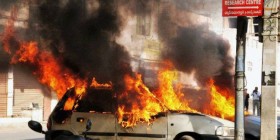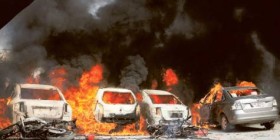A team of international military observers seized by pro-Russian separatists in eastern Ukraine was freed Saturday as Kiev resumed military action to tackle the pro-Moscow gunmen who have overrun the region.
Ukrainian troop carriers moved into the eastern city of Kramatorsk, where some residents reported hearing gunfire, as Ukraine’s embattled new leaders launched their most intensive effort yet to try to dislodge the rebels who have reportedly seized government buildings in nearly a dozen cities and towns.
Saturday’s release of the monitors from the Organisation for Security and Cooperation in Europe resolves a major diplomatic issue for the West after separatists had abducted eight European observers in the flashpoint city of Slavyansk on April 25 and held them hostage.
The monitors — from Germany, Denmark, Poland and Czech Republic — were seized alongside five Ukrainians from the defense ministry. One of the observers, a Swede, was released soon after for medical reasons.
The self-declared mayor of Slavyansk, Vyacheslav Ponomarev, confirmed the release of the remaining 12 members of the mission, adding Russian envoy Vladimir Lukin, who arrived in eastern Ukraine on Friday, had helped negotiate their release.
On the road out of Slavyansk, an OSCE delegation waited to collect the observers, who hugged their colleagues on arrival. Ponomarev told CNN there had been no prisoner exchange.
“Right now we are expecting another storming of the town,” he said.
The OSCE confirmed the release. British Foreign Secretary William Hague welcomed the news in a tweet, adding “all other hostages held by illegal armed groups should be released.”
Military operations
On Saturday, Kiev’s government confirmed a second day of military operations in the east.
Interior Minister Arsen Avakov said the “active phase of the operation” would resume at dawn, with Ukrainian forces taking a television tower in Kramatorsk, some 16 kms (10 miles) from Slavyansk.
“We are not stopping,” Avakov wrote on his Facebook page.
Residents were warned to stay indoors and off the streets.
“Fighting in Kramatorsk,” Avakov later posted on his Facebook account, adding Ukrainian “special units were instructed to stop the provocation.”
A CNN team on the outskirts of the city saw troop carriers moving toward the city center. Local residents described hearing gunfire in certain neighborhoods.
Amateur video posted online showed burnt out buses near the local administration in the city with residents calmly observing and even photographing the plumes of smoke. CNN could not confirm the authenticity of the video.
On Friday, Kiev launched its biggest push yet to reassert its control over separatist areas in the east, hundreds of miles away from the capital.
This came as rebels in Slavyansk shot down two Ukrainian helicopters, killing two crew, the defense ministry said.
In addition, five pro-Russian separatists and two civilians were killed in the city in a Ukrainian military operation, Ponomarev said.
Slavyansk is strategically key because Ukraine has a stockpile of assault rifles and other light weapons near the city, according to Britain’s Royal United Services Institute defense think-tank.
“Today, Kiev has upped the ante in the standoff and will test Russian resolve to prevent the Ukrainian government from regaining control of the city and its light weapons stockpile,” it said in a commentary.
Bloodshed in Odessa
Clashes in the Black Sea city of Odessa sparked a fire that killed at least 31 according to police on Friday, raising the question of whether the country can stave off a possible civil war.
Forty-six people died following the blaze that started at a trade union building amid clashes, a spokesperson for the local prosecutor’s office told CNN, in what was by far the worst incident in Ukraine since a February uprising that ended with a pro-Moscow President fleeing the country.
“We have identified very few bodies, but they were all local residents,” the spokesperson said Saturday.
Odessa, a vibrant multi-ethnic port city, has seen some support for separatists, but nothing like the riots that erupted on Friday.
Ukraine’s security service blamed the unrest in Odessa on “provocateurs.”
“Illegal military groups from unrecognized groups participated in the events and were co-ordinated by provocateurs from the Russian Federation,” the SBU security service said in a statement.
It said former top officials, once part of ousted Ukrainian President Viktor Yanukovych’s inner circle and now “hiding in a neighboring country,” had financed “provocateurs” to foment the unrest.
Video posted on YouTube appeared to show supporters of Kiev throwing Molotov cocktails at the building where pro-Russian separatists had reportedly taken up positions. The footage, which CNN could not independently confirm, showed people sitting on ledges trying to escape the fire and thick smoke.
Kiev’s interior ministry said authorities had started three criminal investigations into the events.
“Police have detained 160 people who were most likely ‘active participants during the incidents’,” the ministry said on its website.
The violence in Ukraine pits pro-Russian separatists against Ukrainian forces and those who support the government in Kiev. It prompted a meeting of the U.N. Security Council, with Russia demanding an end to what it called Ukrainian aggression and Western powers accusing Moscow of funding the violence
U.S. President Barack Obama and German Chancellor Angela Merkel pledged on Friday to seek harsher sanctions against Russia if Ukraine doesn’t stabilize in time for elections this month. But the threat seemed to do little to waive off Moscow, with its foreign ministry saying Ukraine’s use of its military in Slavyansk is criminal.
Russia and the West squared off diplomatically over the fate of Ukraine after Moscow annexed the Black Sea peninsula of Crimea in March following Yanukovych’s ouster. He was pushed from office after months of protests by people upset that he had turned away from Europe in favor of Moscow.
‘Last nail in the coffin’
Russian President Vladimir Putin’s spokesman, Dmitry Peskov, told CNN the military operation was “the last nail in the coffin” for the deal agreed to last month in Geneva, Switzerland, which called for illegal militia groups in eastern Ukraine to disarm and vacate seized buildings.
In a televised phone interview, on Saturday, Peskov said Russia had received thousands of phone calls in the past 24 hours from people in southeastern regions in Ukraine asking for help.
The callers said the situation in those regions “is horrendous,” and “most of the people literally demand active help from Russia,” Peskov said, adding Putin was being notified of the calls.
Slavyansk residents were warned on Friday to stay home and avoid windows as the latest phase of the authorities’ “anti-terrorist operation” got under way.
Kiev’s defense ministry said the two Mi24 helicopters were downed with mobile air defense systems. Another army helicopter, an Mi8, was damaged, but no one was hurt, it said.
Pro-Russian separatists took one badly injured pilot hostage after his helicopter was forced to make an emergency landing, the ministry said, and efforts to free him are ongoing.
Ukraine’s SBU said one helicopter that came under attack was carrying medics, one of whom was injured.






Leave a reply